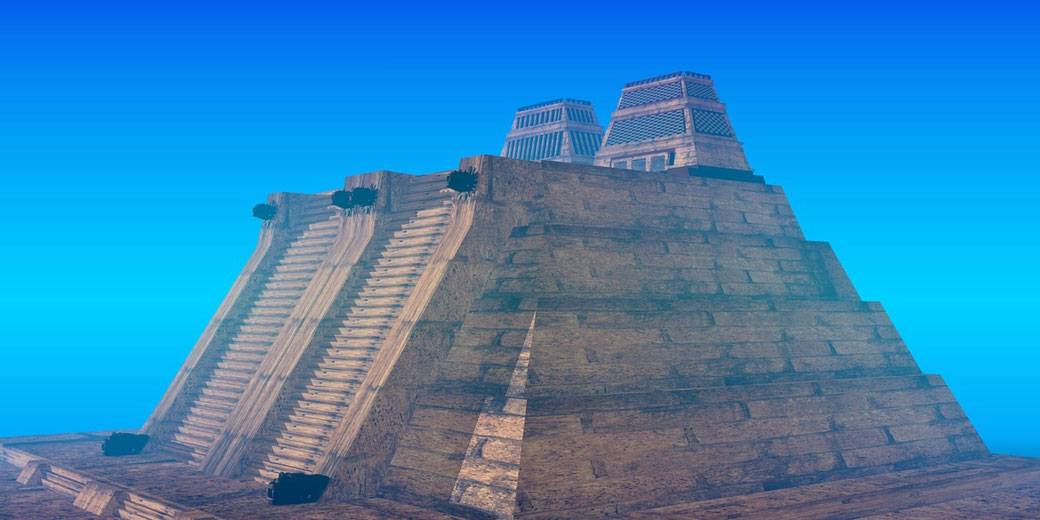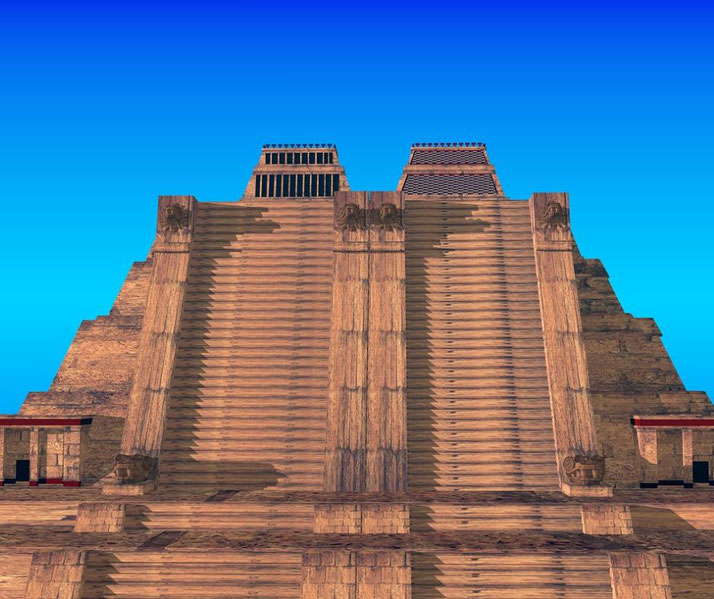The Templo Mayor: The gruesome epicentre of the Aztec cult of human sacrifice

In the middle of the ancient Aztec capital city of Tenochtitlan was the Templo Mayor, the most sacred building in the Aztec world.
Its twin staircases and towering raised platforms dominated the sacred area, where priests sacrificed human victims to sustain divine forces.
Every engraving and blood-stained altar was a reminder of their belief that life itself depended on regular sacrificial offerings to the gods.
Why the Aztecs built the Templo Mayor
According to Aztec religious belief, the gods had given their lives to create the Fifth Sun, which sustained the world.
In return, the Mexica people believed they had a sacred duty to offer human blood and hearts in ritual sacrifice.
The Templo Mayor became the central site for carrying out these ceremonies, with its two shrines symbolising the forces that oversaw their lives.
At the summit, one shrine honoured Huitzilopochtli, god of the sun and war, while the other honoured Tlaloc, god of rain and fertility.
These divine powers shaped the rhythm of life, from seasonal rains to imperial campaigns.
Every victory in battle supplied more captives for sacrifice, while each ceremony secured favour from the gods.
According to the Mexica view of the cosmos, Tenochtitlan lay at the very centre of the universe.
The Templo Mayor was at the heavenly intersection of heaven, earth, and the underworld.
Its position, building, and positioning all meant to cement the idea that the Aztec capital controlled the divine balance of the world.
As such, the priests conducted rituals to protect that balance and to ensure the continued movement of the sun.
Builders aligned the temple with Mount Tlaloc and the rising sun near the December solstice, which integrated astronomical accuracy with spiritual symbolism.
However, some modern scholars debate whether the positioning marked the equinox or other key solar events.
During major festivals, the entire city focused on the temple. The layout of the surrounding sacred area guided participants through a spiritual journey that ended in sacrifice.
Power and religion blended in a public theatre that reaffirmed the authority of the state and the necessity of devotion.
How did the Aztecs build the Templo Mayor?
From the early years of Tenochtitlan’s foundation in 1325, the Mexica began constructing what would become the Templo Mayor.
Over the next two centuries, they rebuilt and expanded it several times, each version growing in size and level of detail.
Archaeologists have identified at least seven major construction phases, each one laid directly over the last.
These phases corresponded to major political events, including the reigns of rulers such as Itzcoatl, Axayacatl, and Ahuitzotl.
According to surviving accounts and excavation evidence, the builders used local volcanic stone, adobe, lime plaster, and painted stucco.
Labourers carried these materials over water and along causeways, while skilled sculptors were responsible for decorating the building with images of gods, serpents, and sacred symbols.
Each reconstruction often corresponded with imperial events, such as a military campaign or the rise to power of a new ruler, although some phases may have aligned with ritual cycles or religious obligations.
During the reign of Ahuitzotl, the final major expansion of the temple reached nearly 30 metres in height.
Its staircases led to twin shrines, where priests performed blood sacrifices beneath banners of turquoise and featherwork.
Surrounding the pyramid, the sacred area, featured altars, elite schools, skull racks, and religious raised areas that supported daily and seasonal rituals.
The temple base itself measured approximately 100 by 80 metres, anchoring it firmly within the heart of the capital.

The religious rituals conducted at the Templo Mayor
During the Aztec ritual calendar, priests performed hundreds of ceremonies at the Templo Mayor.
Some honoured deities of rain or maize, while others demanded the offering of human hearts to keep the sun from falling into darkness.
The most elaborate rituals unfolded on the upper raised areas, where sacrificial victims met their end in front of a watching crowd.
Priests stretched the victim across a stone altar, cut open the chest with a sharp obsidian blade, and lifted the heart toward the sky.
Blood covered the platform and trickled down the steps: a visible sign that the gods had received their due.
Bodies were then pushed down the stairs and landed at the base, where further rituals sometimes followed.
In many ceremonies, the extracted hearts were placed in cuauhxicalli vessels as offerings to Huitzilopochtli.
During Tlacaxipehualiztli, one of the major festivals, warriors honoured Xipe Totec through a ritual in which they flayed victims and then wore their skins.
In another ritual, children were offered to Tlaloc, as their tears were believed to bring rain.
Each ceremony followed a strict order, involving drumming, incense, singing, feasting, and costume.
Victims sometimes underwent several days of purification, dance, and a formal procession before they ascended the steps.
In front of the temple, large crowds gathered to witness the sacrifice, and sources suggest they included people from different social groups, though the exact makeup remains uncertain.
While the ceremonies pleased the gods, they also reinforced the divine status of the Aztec rulers, as every ritual became a statement of religious power and military power.
Also, coronation ceremonies often included sacrifices to validate a ruler's spiritual authority.
On important dates thoughout the year, the numbers of victims rose into the hundreds or even thousands.
The scale of sacrifice demonstrated the wealth of the empire, the reach of its armies, and the determination of its rulers to maintain heavenly order through the ritual offering of life.
Spanish accounts claimed that during the rededication of the sixth temple in 1487, thousands of captives were sacrificed over four days, though modern scholars view such numbers as likely exaggerated or symbolic.
The dramatic destruction of the temple
After Hernán Cortés and his Spanish forces entered Tenochtitlan in 1519, their accounts described shock at the blood-drenched altars, the skull racks, and the steady rhythm of sacrifice.
Their horror contributed to rising hostility, which soon exploded into violence.
During the siege of 1521, Spanish and Tlaxcalan troops assaulted the city over a period of three months.
After the Mexica surrendered, Spanish forces began dismantling the Templo Mayor.
They tore down its staircases, broke apart the shrines, and used the carved stones to build churches and administrative buildings for the new colonial capital.
In place of the temple, the Spaniards constructed the Metropolitan Cathedral. This was a deliberate attempt to replace Aztec religious authority with Spanish Catholic power.
Bernal Díaz del Castillo, a soldier and historian, recorded descriptions of the temple’s former glory before its destruction, including the scale of sacrifices and the number of skulls on display.
Throughout the early colonial period, buildings rose over the ruins of the sacred area.
The Templo Mayor disappeared under layers of rubble, lime, and pavement. Over time, its exact location faded from public memory.
How Templo Mayor was suddenly rediscovered
In the late 19th and early 20th centuries, Mexican archaeologists such as Leopoldo Batres and later Manuel Gamio began probing the foundations of colonial buildings near the cathedral.
During the 1910s, Manuel Gamio led limited excavations that uncovered parts of Aztec-era raised areas.
However, his work remained largely unnoticed and further excavations stalled.
On 21 February 1978, workers who were laying underground cables struck a massive circular stone.
The engraving showed the dismembered body of Coyolxauhqui, sister of Huitzilopochtli.
Experts immediately identified the legendary scene and correctly identified the location as part of the Templo Mayor.
This discovery prompted the Mexican government to launch a full archaeological investigation.
Under the direction of Eduardo Matos Moctezuma, excavators removed modern buildings and colonial debris.
The team uncovered large parts of the pyramid base, ritual offerings, and adjoining structures.
The depth and preservation of the finds amazed researchers. Between 1978 and the mid-1980s, Matos Moctezuma led the Programa de Arqueología Urbana, which uncovered over 200 ritual deposits containing thousands of individual artefacts.
Following these discoveries, the government constructed the Templo Mayor Museum, which was completed in 1987, and it is now considered one of Mexico City’s most important cultural institutions.
The museum holds artefacts from the temple and explains their meaning within Aztec religious life.
Excavation work continues to this day, as archaeologists regularly uncover new chambers, offerings, and sculptures.
The greatest archaeological finds from the Templo Mayor
At the base of the stairway leading to the shrine of Huitzilopochtli, excavators uncovered the Coyolxauhqui Stone.
Measuring over three metres across, it depicted the moon goddess slain and torn apart.
According to Mexica myth, her brother killed her in defence of their mother. The position of the stone matched the ritual in which victims were cast down the stairs after their hearts had been removed.
In burial offerings and sealed chambers, archaeologists discovered thousands of artefacts.
Jade figurines, obsidian knives, coral, conch shells, gold jewellery, and carved incense burners revealed the variety and quality of Aztec religious objects.
The presence of marine items showed long-distance trade and the importance of water and fertility in religious ceremonies.
Some deposits also included the bones of eagles, jaguars, and even human infants, arranged in deliberate symbolic patterns.
Another major find included the ruins of the Huei Tzompantli, the great skull rack.
As part of this, excavators uncovered mortared skulls, architectural sockets, and sculptural images that confirmed Spanish accounts of the macabre displays. R
esearchers believe the rack may have held hundreds of human skulls at once.
Among the most impressive sculptures was the monolith of Tlaltecuhtli, a chthonic earth deity with gaping jaws and flayed skin.
Discovered in 2006, it measured more than four metres long and added new understanding to Aztec beliefs about the underworld and divine sacrifice.
What do you need help with?
Download ready-to-use digital learning resources
Copyright © History Skills 2014-2025.
Contact via email
With the exception of links to external sites, some historical sources and extracts from specific publications, all content on this website is copyrighted by History Skills. This content may not be copied, republished or redistributed without written permission from the website creator. Please use the Contact page to obtain relevant permission.





